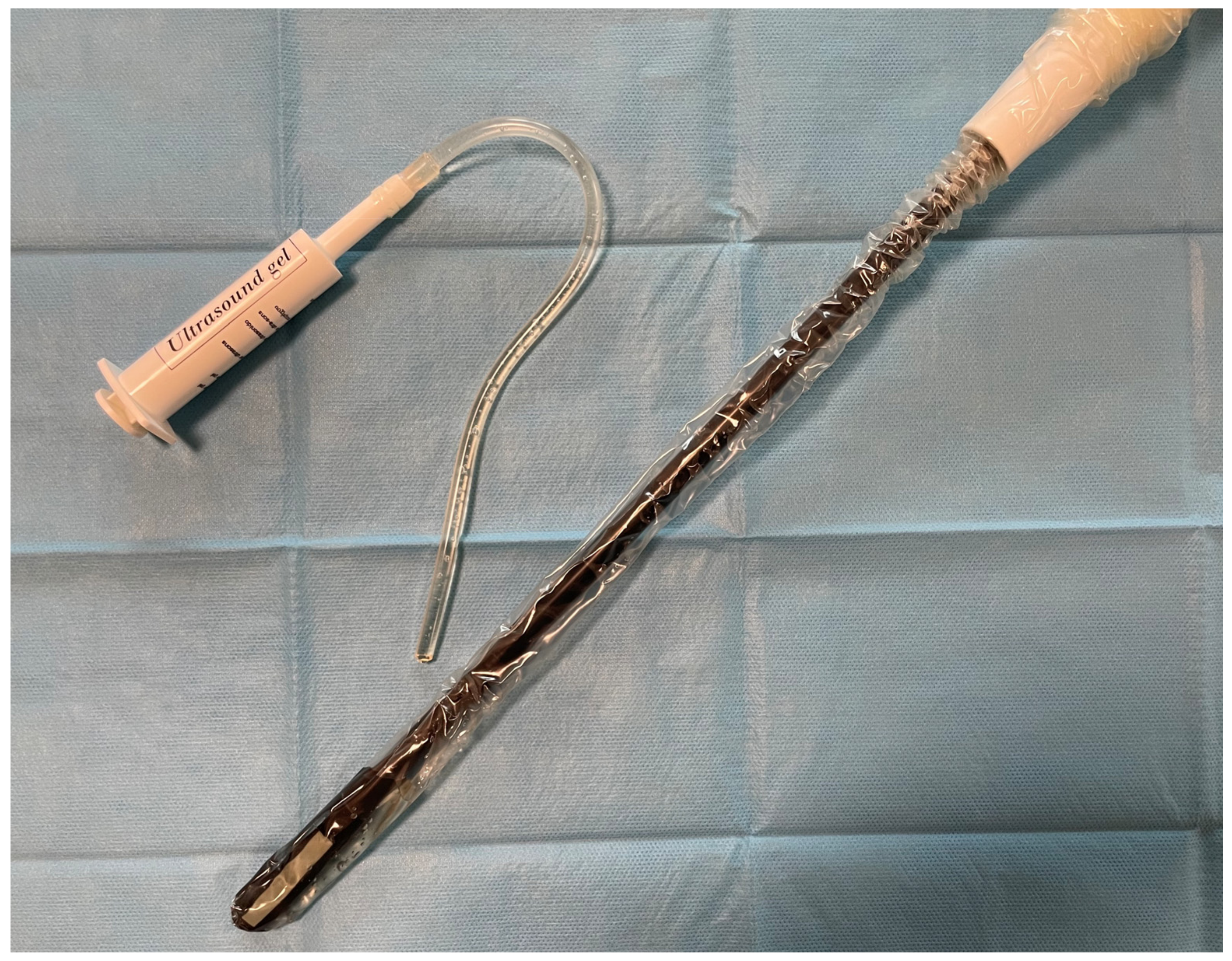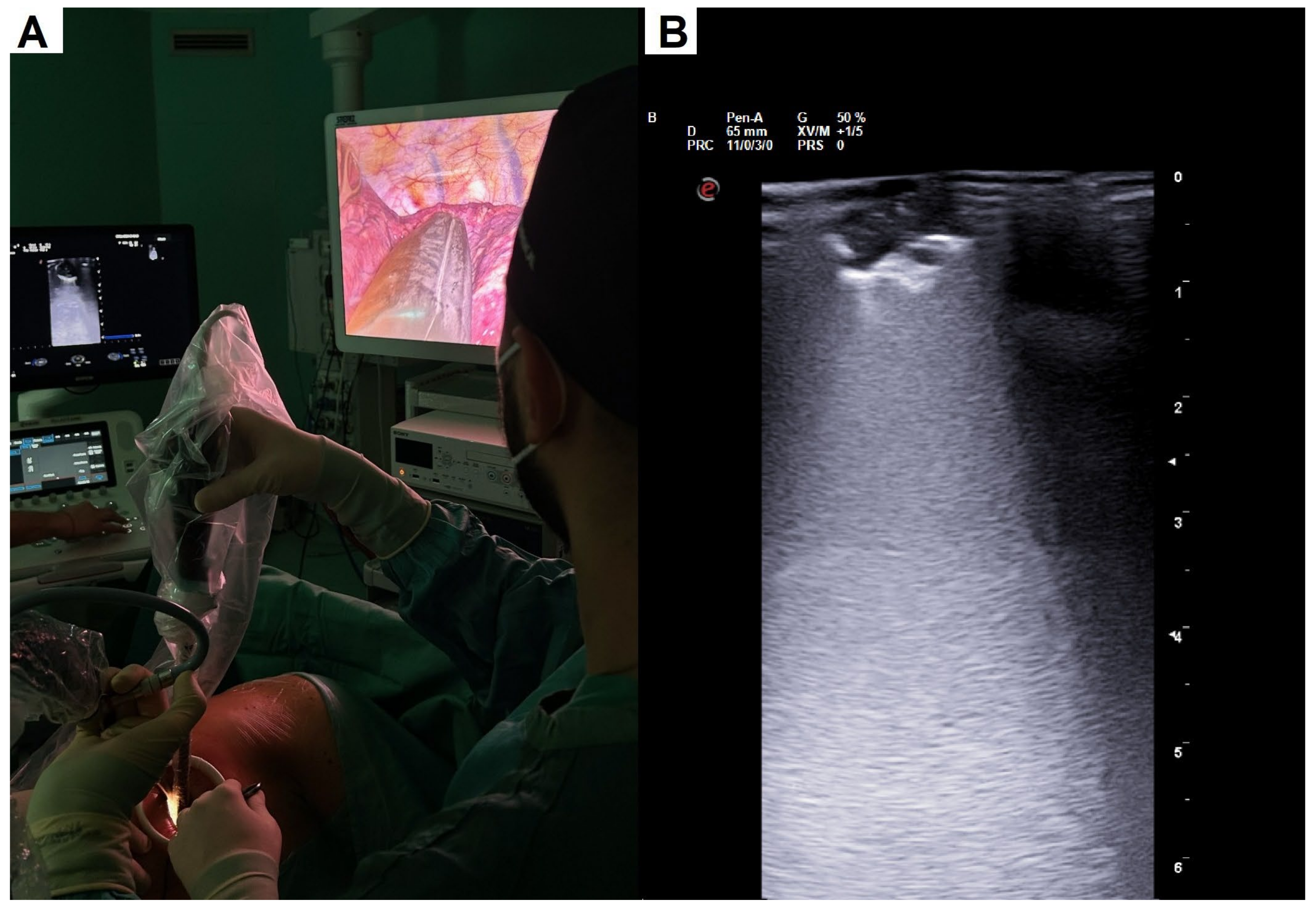Ultrasound for Intra-Operative Detection of Peri-Centimetric Pulmonary Nodules in Uniportal Video-Assisted Thoracic Surgery (VATS): A Comparison with Conventional Techniques in Multiportal VATS
Abstract
1. Introduction
2. Materials and Methods
2.1. Patient Selection
2.2. Surgical Details
2.3. Statistical Analysis
3. Results
3.1. Demographics and Clinical Characteristics
3.2. Intra-Operative Results and Post-Operative Complications
4. Discussion
5. Conclusions
Author Contributions
Funding
Institutional Review Board Statement
Informed Consent Statement
Data Availability Statement
Acknowledgments
Conflicts of Interest
References
- Sung, H.; Ferlay, J.; Siegel, R.L.; Laversanne, M.; Soerjomataram, I.; Jemal, A.; Bray, F. Global Cancer Statistics 2020: GLOBOCAN Estimates of Incidence and Mortality Worldwide for 36 Cancers in 185 Countries. CA Cancer J. Clin. 2021, 71, 209–249. [Google Scholar] [CrossRef] [PubMed]
- Adams, S.J.; Stone, E.; Baldwin, D.R.; Vliegenthart, R.; Lee, P.; Fintelmann, F.J. Lung cancer screening. Lancet 2023, 401, 390–408. [Google Scholar] [CrossRef] [PubMed]
- National Lung Screening Trial Research Team; Aberle, D.R.; Adams, A.M.; Berg, C.D.; Black, W.C.; Clapp, J.D.; Fagerstrom, R.M.; Gareen, I.F.; Gatsonis, C.; Marcus, P.M.; et al. Reduced lung-cancer mortality with low-dose computed tomographic screening. N. Engl. J. Med. 2011, 365, 395–409. [Google Scholar] [CrossRef] [PubMed] [PubMed Central]
- Zhao, R.; Shi, Z.; Cheng, S. Uniport video assisted thoracoscopic surgery (U-VATS) exhibits increased feasibility, non-inferior tolerance, and equal efficiency compared with multiport VATS and open thoracotomy in the elderly non-small cell lung cancer patients at early stage. Medicine 2019, 98, e16137. [Google Scholar] [CrossRef] [PubMed] [PubMed Central]
- Sui, X.; Zhao, H.; Yang, F.; Li, J.L.; Wang, J. Computed tomography guided microcoil localization for pulmonary small nodules and ground-glass opacity prior to thoracoscopic resection. J. Thorac. Dis. 2015, 7, 1580–1587. [Google Scholar] [CrossRef] [PubMed] [PubMed Central]
- Mogi, A.; Yajima, T.; Tomizawa, K.; Onozato, R.; Tanaka, S.; Kuwano, H. Video-Assisted Thoracoscopic Surgery after Preoperative CT-Guided Lipiodol Marking of Small or Impalpable Pulmonary Nodules. Ann. Thorac. Cardiovasc. Surg. 2015, 21, 435–439. [Google Scholar] [CrossRef] [PubMed] [PubMed Central]
- Bellomi, M.; Veronesi, G.; Trifirò, G.; Brambilla, S.; Bonello, L.; Preda, L.; Casiraghi, M.; Borri, A.; Paganelli, G.; Spaggiari, L. Computed tomography-guided preoperative radiotracer localization of nonpalpable lung nodules. Ann. Thorac. Surg. 2010, 90, 1759–1764. [Google Scholar] [CrossRef] [PubMed]
- Nagai, K.; Kuriyama, K.; Inoue, A.; Yoshida, Y.; Takami, K. Computed tomography-guided preoperative localization of small lung nodules with indocyanine green. Acta Radiol. 2018, 59, 830–835. [Google Scholar] [CrossRef] [PubMed]
- Findik, G.; Demiröz, S.M.; Apaydın, S.M.K.; Ertürk, H.; Biri, S.; Incekara, F.; Aydogdu, K.; Kaya, S. Computed Tomography-Guided Methylene Blue Labeling Prior to Thoracoscopic Resection of Small Deeply Placed Pulmonary Nodules. Do We Really Need Palpation? Thorac. Cardiovasc. Surg. 2017, 65, 387–391. [Google Scholar] [CrossRef] [PubMed]
- Matsumoto, S.; Hirata, T.; Ogawa, E.; Fukuse, T.; Ueda, H.; Koyama, T.; Nakamura, T.; Wada, H. Ultrasonographic evaluation of small nodules in the peripheral lung during video-assisted thoracic surgery (VATS). Eur. J. Cardiothorac. Surg. 2004, 26, 469–473. [Google Scholar] [CrossRef] [PubMed]
- Partlow, J.; Thomas, S.; Nicolini, M.; Greeno, S.; Schroeder, C. Image-Guided VATS in the Hybrid Operation Room Facilitates Early Diagnosis and Concurrent Treatment of Subcentimeter Nonpalpable Lung Nodules. Innovations 2024, 19, 136–142. [Google Scholar] [CrossRef] [PubMed]
- Machi, J.; Sigel, B.; Zaren, H.A.; Schwartz, J.; Hosokawa, T.; Kitamura, H.; Kolecki, R.V. Technique of ultrasound examination during laparoscopic cholecystectomy. Surg. Endosc. 1993, 7, 544–549. [Google Scholar] [CrossRef] [PubMed]
- Sperandeo, M.; Rotondo, A.; Guglielmi, G.; Catalano, D.; Feragalli, B.; Trovato, G.M. Transthoracic ultrasound in the assessment of pleural and pulmonary diseases: Use and limitations. Radiol. Med. 2014, 119, 729–740. [Google Scholar] [CrossRef] [PubMed]
- Greenfield, A.L.; Steiner, R.M.; Liu, J.B.; Cohn, H.E.; Goldberg, B.B.; Rawool, N.M.; Merton, D.A. Sonographic guidance for the localization of peripheral pulmonary nodules during thoracoscopy. Am. J. Roentgenol. 1997, 168, 1057–1060, Erratum in Am. J. Roentgenol. 1997, 168, 1625. [Google Scholar] [CrossRef] [PubMed][Green Version]
- Santambrogio, R.; Montorsi, M.; Bianchi, P.; Mantovani, A.; Ghelma, F.; Mezzetti, M. Intraoperative ultrasound during thoracoscopic procedures for solitary pulmonary nodules. Ann. Thorac. Surg. 1999, 68, 218–222. [Google Scholar] [CrossRef] [PubMed]
- Rocco, G.; Cicalese, M.; La Manna, C.; La Rocca, A.; Martucci, N.; Salvi, R. Ultrasonographic identification of peripheral pulmonary nodules through uniportal video-assisted thoracic surgery. Ann. Thorac. Surg. 2011, 92, 1099–1101. [Google Scholar] [CrossRef] [PubMed]
- Taurchini, M.; Quarato, C.M.I.; Frongillo, E.M.; Ferretti, G.M.; Cipriani, C.; Bizzarri, M.; Foschino Barbaro, M.P.; Lacedonia, D.; Simeone, A.; Graziano, P.; et al. Intraoperative Lung Ultrasound (ILU) for the Assessment of Pulmonary Nodules. Diagnostics 2021, 11, 1691. [Google Scholar] [CrossRef] [PubMed] [PubMed Central]
- Huang, Y.H.; Chen, K.C.; Chen, J.S. Ultrasound for intraoperative localization of lung nodules during thoracoscopic surgery. Ann. Transl. Med. 2019, 7, 37. [Google Scholar] [CrossRef] [PubMed] [PubMed Central]
- Khereba, M.; Ferraro, P.; Duranceau, A.; Martin, J.; Goudie, E.; Thiffault, V.; Liberman, M. Thoracoscopic localization of intraparenchymal pulmonary nodules using direct intracavitary thoracoscopic ultrasonography prevents conversion of VATS procedures to thoracotomy in selected patients. J. Thorac. Cardiovasc. Surg. 2012, 144, 1160–1165. [Google Scholar] [CrossRef] [PubMed]
- Gambardella, C.; Messina, G.; Pica, D.G.; Bove, M.; Capasso, F.; Mirra, R.; Natale, G.; D’Alba, F.P.; Caputo, A.; Leonardi, B.; et al. Intraoperative lung ultrasound improves subcentimetric pulmonary nodule localization during VATS: Results of a retrospective analysis. Thorac. Cancer. 2023, 14, 2558–2566. [Google Scholar] [CrossRef] [PubMed] [PubMed Central]
- Schauer, M.I.; Jung, E.M.; Platz Batista da Silva, N.; Akers, M.; Loch, E.; Markowiak, T.; Piler, T.; Larisch, C.; Neu, R.; Stroszczynski, C.; et al. Intraoperative Contrast-Enhanced Ultrasonography (Io-CEUS) in Minimally Invasive Thoracic Surgery for Characterization of Pulmonary Tumours: A Clinical Feasibility Study. Cancers 2023, 15, 3854. [Google Scholar] [CrossRef] [PubMed] [PubMed Central]
- Sperandeo, M.; Venuti, M.; Quarato, C.M.I. Uniportal versus multiportal video-assisted thoracic surgery for lung cancer: Safety and advantages in employing complementary intraoperative lung ultrasound. J. Thorac. Dis. 2020, 12, 3013–3017. [Google Scholar] [CrossRef] [PubMed] [PubMed Central]
- Messina, G.; Bove, M.; Natale, G.; Noro, A.; Martone, M.; Opromolla, G.; Di Filippo, V.; Leonardi, B.; Fasano, M.; Polito, R.; et al. Ultrasound location of ground-glass opacity during thoracoscopic surgery. Interact. Cardiovasc. Thorac. Surg. 2022, 35, ivac234. [Google Scholar] [CrossRef] [PubMed] [PubMed Central]


| Variable | Group A (n = 31) | Group B (n = 33) | p-Value |
|---|---|---|---|
| Median age, years (IQR) | 70 (66–76) | 71 (65.7–75.2) | 0.99 |
| Gender, n (%) | 0.81 | ||
| male | 16 (51.6%) | 18 (54.5%) | |
| female | 15 (48.4%) | 15 (45.5%) | |
| Nodule diameter, mm (IQR) | 11 (9–13) | 11 (9–12) | 0.92 |
| Nodule location, n (%) | 0.85 | ||
| right upper lobe | 8 (25.8%) | 9 (27.3%) | |
| middle lobe | 2 (6.5%) | 3 (9.1%) | |
| right inferior lobe | 4 (12.9%) | 6 (18.2%) | |
| left upper lobe | 9 (29.0%) | 10 (30.3%) | |
| left inferior lobe | 8 (25.8%) | 5 (15.1%) | |
| Final histology, n (%) | 0.47 | ||
| Adenocarcinoma | 14 (45.2%) | 18 (54.5%) | |
| Squamous cell carcinoma | 9 (29.0%) | 5 (15.2%) | |
| Pulmonary metastasis | 2 (6.5%) | 1 (3.0%) | |
| Benign lesion | 6 (19.3%) | 9 (27.3%) |
| Variable | Group A (n = 31) | Group B (n = 33) | p-Value |
|---|---|---|---|
| Detection time, minutes (IQR) | 9 (8–10) | 14 (12.5–15) | <0.001 |
| Operative time, minutes (IQR) | 33 (29–38) | 43 (39–47) | <0.001 |
| Nodule distance from pleural surface, mm (IQR) | 27 (25–28) | 26 (24–28) | 0.54 |
| Need of additional wedge, n (%) | 0.086 | ||
| yes | 0 (0.0%) | 3 (9.1%) | |
| no | 31 (100.0%) | 30 (90.9%) | |
| Post-operative complication, n (%) | 0.16 | ||
| yes | 0 (0.0%) | 2 (6.1%) | |
| no | 31 (100.0%) | 31 (93.9%) |
Disclaimer/Publisher’s Note: The statements, opinions and data contained in all publications are solely those of the individual author(s) and contributor(s) and not of MDPI and/or the editor(s). MDPI and/or the editor(s) disclaim responsibility for any injury to people or property resulting from any ideas, methods, instructions or products referred to in the content. |
© 2024 by the authors. Licensee MDPI, Basel, Switzerland. This article is an open access article distributed under the terms and conditions of the Creative Commons Attribution (CC BY) license (https://creativecommons.org/licenses/by/4.0/).
Share and Cite
Bastone, S.A.; Patirelis, A.; Luppichini, M.; Ambrogi, V. Ultrasound for Intra-Operative Detection of Peri-Centimetric Pulmonary Nodules in Uniportal Video-Assisted Thoracic Surgery (VATS): A Comparison with Conventional Techniques in Multiportal VATS. J. Clin. Med. 2024, 13, 4448. https://doi.org/10.3390/jcm13154448
Bastone SA, Patirelis A, Luppichini M, Ambrogi V. Ultrasound for Intra-Operative Detection of Peri-Centimetric Pulmonary Nodules in Uniportal Video-Assisted Thoracic Surgery (VATS): A Comparison with Conventional Techniques in Multiportal VATS. Journal of Clinical Medicine. 2024; 13(15):4448. https://doi.org/10.3390/jcm13154448
Chicago/Turabian StyleBastone, Sebastiano Angelo, Alexandro Patirelis, Matilde Luppichini, and Vincenzo Ambrogi. 2024. "Ultrasound for Intra-Operative Detection of Peri-Centimetric Pulmonary Nodules in Uniportal Video-Assisted Thoracic Surgery (VATS): A Comparison with Conventional Techniques in Multiportal VATS" Journal of Clinical Medicine 13, no. 15: 4448. https://doi.org/10.3390/jcm13154448
APA StyleBastone, S. A., Patirelis, A., Luppichini, M., & Ambrogi, V. (2024). Ultrasound for Intra-Operative Detection of Peri-Centimetric Pulmonary Nodules in Uniportal Video-Assisted Thoracic Surgery (VATS): A Comparison with Conventional Techniques in Multiportal VATS. Journal of Clinical Medicine, 13(15), 4448. https://doi.org/10.3390/jcm13154448






